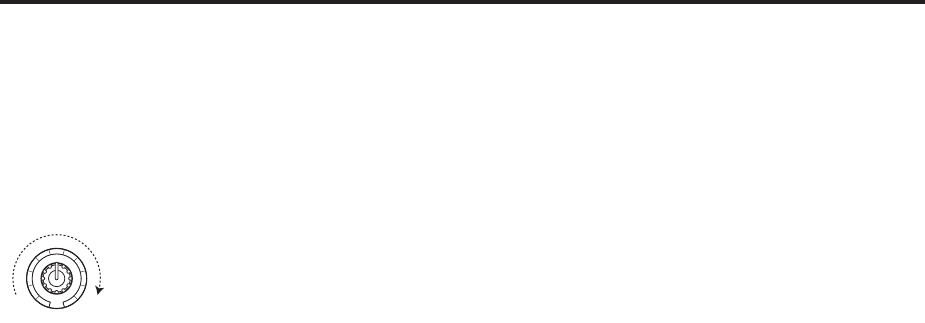
Appendices
968
Knob Mod.8 (CC#21)
This AMS source always responds to MIDI CC#21, and
will usually also correspond to Knob 8(USER 4). For
more information, see “Knob Mod.5 (CC#17)” on
page 967.
Knob Mod5 [+] (CC#17)
This is similar to “Knob Mod.5 (CC#17)” on page 967,
except that the range goes from 0 at the far left to +99 at
the far right, corresponding to MIDI CC values of 0
and 127 respectively.
For more information, see “Knob Mod.5 (CC#17)” on
page 967.
Knob Mod6 [+] (CC#19)
This is similar to “Knob Mod.6 (CC#19)” on page 967,
except that the range goes from 0 at the far left to +99 at
the far right, corresponding to MIDI CC values of 0
and 127 respectively.
For more information, see “Knob Mod.5 (CC#17)” on
page 967.
Knob Mod7 [+] (CC#20)
This is similar to “Knob Mod.7 (CC#20)” on page 967,
except that the range goes from 0 at the far left to +99 at
the far right, corresponding to MIDI CC values of 0
and 127 respectively.
For more information, see “Knob Mod.5 (CC#17)” on
page 967.
Knob Mod8 [+] (CC#21)
This is similar to “Knob Mod.8 (CC#21)” on page 968,
except that the range goes from 0 at the far left to +99 at
the far right, corresponding to MIDI CC values of 0
and 127 respectively.
For more information, see “Knob Mod.5 (CC#17)” on
page 967.
Damper (CC#64)
This is the Damper pedal, also sometimes called the
sustain pedal. It corresponds to MIDI CC#64.
When using Korg’s optional half-damper pedal, the
DS-1H, this AMS source is continuous–not just on/off.
Porta. SW (CC#65)
This is the MIDI portamento switch (CC#65), which
also enables and disables portamento.
Sostenuto (CC#66)
This is the MIDI sostenuto pedal (CC#66).
Soft (CC#67)
This is the MIDI oft pedal (CC#67).
SW1 Mod. (CC#80)
This isCC#80, which is the default for assignable front-
panel switch 1 (SW1). To use SW1 and SW2 as AMS
sources:
1. Go to the Set Up Controllers page.
2. Under Panel Switch Assign, assign SW1 to SW1
Mod. (CC#80) and SW2 to SW2 Mod. (CC#81).
These assignments are stored separately for each
Program, Combination, and Song.
For more information, see “SW1/2 Assignments” on
page 979.
SW2 Mod. (CC#81)
This isCC#81, which is the default for assignable front-
panel switch 2 (SW2). For more information, see “SW1
Mod. (CC#80),” above.
Foot Switch (CC#82)
This AMS source receives MIDI CC#82. It can also be
generated by a foot switch connected to the rear-panel
ASSIGNABLE SWITCH input, if the Global Foot Pedal
Assign parameter is set to Foot Switch (CC#82). For
more information, see “Foot Switch Assignments” on
page 981.
Controller (CC#83)
MIDI control change (CC#83)
VJS +X Mod.(CC#85)
This is MIDI CC#85, which is the default assignment
for horizontal movement of the vector joystick, to the
right of the center point.
To use the vector joystick as an AMS source, go to the
Vector Control page or Vector CC page for each
program, combination, or song, and set the “Vector CC
Control” parameters as below:
+X: VJS +X Mod. (CC#85)
-X: VJS –X Mod. (CC#86)
+Y: VJS +Y Mod. (CC#87)
-Y: VJS –Y Mod. (CC#88)
Note: If “VJS X/Y Mode” is Positive or Negative, you’ll
be able to use either + or –, not both.
VJS –X Mod.(CC#86)
This is the horizontal movement of the vector joystick,
to the left of the center point. It corresponds to MIDI
CC#86.
For more information, see “VJS +X Mod.(CC#85),”
above.
VJS +Y Mod.(CC#87)
This is the vertical movement of the vector joystick,
upwards from the center point. It corresponds to MIDI
CC#87.
For more information, see “VJS +X Mod.(CC#85),”
above.
VJS –Y Mod.(CC#88)
This is the vertical movement of the vector joystick,
downwards from the center point. It corresponds to
MIDI CC#87.
For more information, see “VJS +X Mod.(CC#85),”
above.
0 +99


















